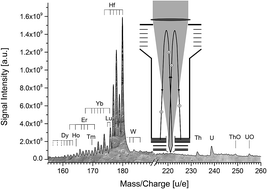当前位置:
X-MOL 学术
›
J. Anal. At. Spectrom.
›
论文详情
Our official English website, www.x-mol.net, welcomes your
feedback! (Note: you will need to create a separate account there.)
Improved detection sensitivity for heavy trace elements using a miniature laser ablation ionisation mass spectrometer
Journal of Analytical Atomic Spectrometry ( IF 3.1 ) Pub Date : 2017-08-21 00:00:00 , DOI: 10.1039/c7ja00193b R. Wiesendanger 1, 2, 3, 4, 5 , M. Tulej 1, 2, 3, 4 , A. Riedo 1, 2, 3, 4, 6 , S. Frey 1, 2, 3, 4 , H. Shea 4, 5, 7 , P. Wurz 1, 2, 3, 4
Journal of Analytical Atomic Spectrometry ( IF 3.1 ) Pub Date : 2017-08-21 00:00:00 , DOI: 10.1039/c7ja00193b R. Wiesendanger 1, 2, 3, 4, 5 , M. Tulej 1, 2, 3, 4 , A. Riedo 1, 2, 3, 4, 6 , S. Frey 1, 2, 3, 4 , H. Shea 4, 5, 7 , P. Wurz 1, 2, 3, 4
Affiliation

|
Laser ablation ionisation time-of-flight mass spectrometry is a versatile technique to obtain highly sensitive measurement of the elements and isotope composition of solid materials. Because of the measurements of nearly all elements in the sample, large ion rates of abundant elements may reduce the detection efficiency for heavier elements arriving later at the detector system. If this occurs, it will affect the capability of quantitative measurements of heavy species. We demonstrate that by implementation of a short high-voltage (HV) pulse, we can remove the high rate ions that reduce the detection efficiency of the ion detector to measure trace elements, which otherwise would not be detectable. The location of a suitable electrode in the given ion optical system, the timing and the pulse shape were determined with the help of numerical ion trajectory simulations using the SIMION software. An HV pulse removes ions of lighter elements, including Na, K, and Mg from the analysed ion beam, which are typically the most abundant species in rocks and soils, allowing sensitive analysis of heavy trace elements. Using standard NIST reference materials we determined detection limits in the sub-ppm range and accomplished isotope ratio measurements of Pb with an accuracy in the per mill range. Further investigations of trace elements of the KREEP material in a lunar sample demonstrate that the miniature LIMS system can be used for in situ analysis of rocks and soils, and for investigations of geological processes and dating.
中文翻译:

使用微型激光烧蚀电离质谱仪提高了对痕量元素的检测灵敏度
激光烧蚀电离飞行时间质谱仪是一种通用技术,可对固体材料的元素和同位素组成进行高度灵敏的测量。由于对样品中几乎所有元素的测量,大量元素的高离子速率可能会降低较重元素的检测效率,而较重元素随后到达检测器系统。如果发生这种情况,将影响重物定量测量的能力。我们证明了通过实施短时高压(HV)脉冲,我们可以去除高速率离子,从而降低了离子检测器测量痕量元素的检测效率,否则将无法检测到。给定离子光学系统中合适电极的位置,使用SIMION软件借助数字离子轨迹模拟确定定时和脉冲形状。高压脉冲从被分析的离子束中去除较轻元素的离子,包括Na,K和Mg,这些离子通常是岩石和土壤中含量最高的物种,从而可以对重的痕量元素进行敏感分析。使用标准的NIST参考材料,我们确定了亚ppm级的检出限,并完成了铅的同位素比测量,精确度达到了每研磨机范围。对月球样品中KREEP材料中微量元素的进一步研究表明,微型LIMS系统可用于 它们通常是岩石和土壤中最丰富的物种,可以对痕量重元素进行灵敏的分析。使用标准的NIST参考材料,我们确定了亚ppm级的检出限,并完成了铅的同位素比测量,精确度达到了每研磨机范围。对月球样品中KREEP材料中微量元素的进一步研究表明,微型LIMS系统可用于 它们通常是岩石和土壤中最丰富的物种,可以对痕量重元素进行灵敏的分析。使用标准的NIST参考材料,我们确定了亚ppm级的检出限,并完成了铅的同位素比测量,精确度达到了每研磨机范围。对月球样品中KREEP材料中微量元素的进一步研究表明,微型LIMS系统可用于岩石和土壤的原位分析,以及地质过程和测年的研究。
更新日期:2017-09-07
中文翻译:

使用微型激光烧蚀电离质谱仪提高了对痕量元素的检测灵敏度
激光烧蚀电离飞行时间质谱仪是一种通用技术,可对固体材料的元素和同位素组成进行高度灵敏的测量。由于对样品中几乎所有元素的测量,大量元素的高离子速率可能会降低较重元素的检测效率,而较重元素随后到达检测器系统。如果发生这种情况,将影响重物定量测量的能力。我们证明了通过实施短时高压(HV)脉冲,我们可以去除高速率离子,从而降低了离子检测器测量痕量元素的检测效率,否则将无法检测到。给定离子光学系统中合适电极的位置,使用SIMION软件借助数字离子轨迹模拟确定定时和脉冲形状。高压脉冲从被分析的离子束中去除较轻元素的离子,包括Na,K和Mg,这些离子通常是岩石和土壤中含量最高的物种,从而可以对重的痕量元素进行敏感分析。使用标准的NIST参考材料,我们确定了亚ppm级的检出限,并完成了铅的同位素比测量,精确度达到了每研磨机范围。对月球样品中KREEP材料中微量元素的进一步研究表明,微型LIMS系统可用于 它们通常是岩石和土壤中最丰富的物种,可以对痕量重元素进行灵敏的分析。使用标准的NIST参考材料,我们确定了亚ppm级的检出限,并完成了铅的同位素比测量,精确度达到了每研磨机范围。对月球样品中KREEP材料中微量元素的进一步研究表明,微型LIMS系统可用于 它们通常是岩石和土壤中最丰富的物种,可以对痕量重元素进行灵敏的分析。使用标准的NIST参考材料,我们确定了亚ppm级的检出限,并完成了铅的同位素比测量,精确度达到了每研磨机范围。对月球样品中KREEP材料中微量元素的进一步研究表明,微型LIMS系统可用于岩石和土壤的原位分析,以及地质过程和测年的研究。









































 京公网安备 11010802027423号
京公网安备 11010802027423号